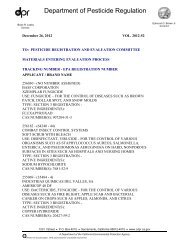Dichlorvos (DDVP) Risk Characterization Document - California ...
Dichlorvos (DDVP) Risk Characterization Document - California ...
Dichlorvos (DDVP) Risk Characterization Document - California ...
You also want an ePaper? Increase the reach of your titles
YUMPU automatically turns print PDFs into web optimized ePapers that Google loves.
Table 7. The incidences of forestomach tumors in mice treated with <strong>DDVP</strong> by gavage for 2<br />
years a .<br />
Dosage (mg/kg-day) b<br />
Tumor types 0 7.1 14.3 28.6<br />
Males<br />
Squamous papilloma 1/46 + 1/50 5/48 ND<br />
( 2%) ( 2%) (10%)<br />
Females<br />
Squamous papilloma 5/44 ++ ND 6/44 18/48**<br />
(11%) (14%) (38%)<br />
Squamous cell carcinoma 0/44 + ND 0/44 2/48<br />
( 0%) ( 0%) ( 4%)<br />
Papilloma or carcinoma 5/44 ++ ND 6/44 19/48**<br />
(11%) (14%) (40%)<br />
a/<br />
b/<br />
Data were from Chan (1989). Incidence rates were expressed as the number of animals<br />
bearing tumors per animals at risk. All animals with at least 52 weeks of exposure or alive<br />
when the first tumor was detected, whichever occurs first, were considered at risk. Level of<br />
statistical significance, p @ 0.05 ( + ) or p @ 0.01 (** or ++ ), is indicated after each incidence.<br />
Significance at the control value is based on a dose-weighted chi-square trend test, and<br />
significance at the dosed groups is for the Fisher's Exact Test. ND is not determined.<br />
Dosages adjusted for 5 days per week dosing.<br />
37
















